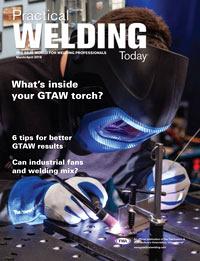- FMA
- The Fabricator
- FABTECH
- Canadian Metalworking
Categories
- Additive Manufacturing
- Aluminum Welding
- Arc Welding
- Assembly and Joining
- Automation and Robotics
- Bending and Forming
- Consumables
- Cutting and Weld Prep
- Electric Vehicles
- En Español
- Finishing
- Hydroforming
- Laser Cutting
- Laser Welding
- Machining
- Manufacturing Software
- Materials Handling
- Metals/Materials
- Oxyfuel Cutting
- Plasma Cutting
- Power Tools
- Punching and Other Holemaking
- Roll Forming
- Safety
- Sawing
- Shearing
- Shop Management
- Testing and Measuring
- Tube and Pipe Fabrication
- Tube and Pipe Production
- Waterjet Cutting
Industry Directory
Webcasts
Podcasts
FAB 40
Advertise
Subscribe
Account Login
Search
What is a repair WPS?
- By Paul Cameron
- Updated February 9, 2024
- March 28, 2016
- Article
- Arc Welding
Q: When codes refer to a "repair WPS [weld procedure specification],” does that mean that a different test needs to be qualified other than the procedures that have already been qualified? If this is the case, would you record the nondestructive evaluation (NDE) and hold points that are required in the WPS?
P.S. Thanks for the time you've taken over the years to let us ask, argue, talk through, and debate all the issues we come across. It only makes us better at what we do.
A: And I thought I was the only one who woke up at 6 a.m. on a Saturday with welding on the brain (I happened to be calibrating my UT scope when I got your e-mail).
Let me concentrate on your first question as it relates to AWS D1.1, because you are right, the Bridge Code is more specific.
Scenarios for Repair WPS
D1.1 requires a repair welding procedure specification (WPS). Why would they state that? In most manufacturing environments we have specific WPSs for certain joint configurations, materials, and welding positions.
Let’s imagine the company, PWC Weld-All, had WPSs for all position, unlimited thickness, base metal group 1 and 2 for lap, T- (fillet and groove), V-, bevel, and square groove joints. Your first impression would be that PWC has his "shizzle" together, right?
Now let's say PWC hired his brother to punch bolt holes in steel with an ironworker. Who could mess that up? Well, his brother did and now you’ve got four 1-in. holes in the web of an S24 by 100 I-beam, and the customer insists they be filled. Which WPS will cover this repair? Since the joint configuration now is a hole in a plate, none of the existing WPSs will apply. We’d have to develop a new WPS, which may or may not require testing (depending on code requirements).
Here's another scenario: The base plate of a light pole tower is welded using gas-shielded flux-cored arc welding (FCAW-G). While the light pole tower is being erected, the customer’s inspector finds unacceptable porosity that must be repaired. That repair could be made with the same procedure that was used to manufacture the tower, but it wouldn’t be practical to use FCAW-G in the field. A procedure would need to be written—and possibly qualified—to complete this repair using another process.
One last scenario: A crack in a weld is discovered in a bevel groove, but the engineer determines it can be repaired. This can typically be done using the original WPS. While excavating you discover that the crack extends into the base material. Now your joint configuration will probably be outside the tolerances of your original WPS, so a new WPS will need to be written and possibly qualified.
Oftentimes the procedure qualification records (PQRs) you've previously completed will cover the repair WPS, but you still need to write the new WPS.
I have written many repair WPSs, and I will include language that is not typically found in a production WPS, things like, “Drill an X/X diameter hole at each tip of the crack to reduce the chances of growth,” or “Once discontinuity is removed, magnetic particle test to ensure its complete removal.”
So your repair WPS isn't any different than any other WPS; you ensure that you've covered all your bases in regard to material, joint configuration, and weld position before moving forward with the repair.
Ask me the time and I build you a watch. Sorry about that.
About the Author

Paul Cameron
Braun Intertec
4210 Highway 14 East
Rochester, MN 55904
About the Publication
subscribe now

The Welder, formerly known as Practical Welding Today, is a showcase of the real people who make the products we use and work with every day. This magazine has served the welding community in North America well for more than 20 years.
start your free subscription- Stay connected from anywhere

Easily access valuable industry resources now with full access to the digital edition of The Fabricator.

Easily access valuable industry resources now with full access to the digital edition of The Welder.

Easily access valuable industry resources now with full access to the digital edition of The Tube and Pipe Journal.
- Podcasting
- Podcast:
- The Fabricator Podcast
- Published:
- 04/16/2024
- Running Time:
- 63:29
In this episode of The Fabricator Podcast, Caleb Chamberlain, co-founder and CEO of OSH Cut, discusses his company’s...
- Industry Events
16th Annual Safety Conference
- April 30 - May 1, 2024
- Elgin,
Pipe and Tube Conference
- May 21 - 22, 2024
- Omaha, NE
World-Class Roll Forming Workshop
- June 5 - 6, 2024
- Louisville, KY
Advanced Laser Application Workshop
- June 25 - 27, 2024
- Novi, MI
































